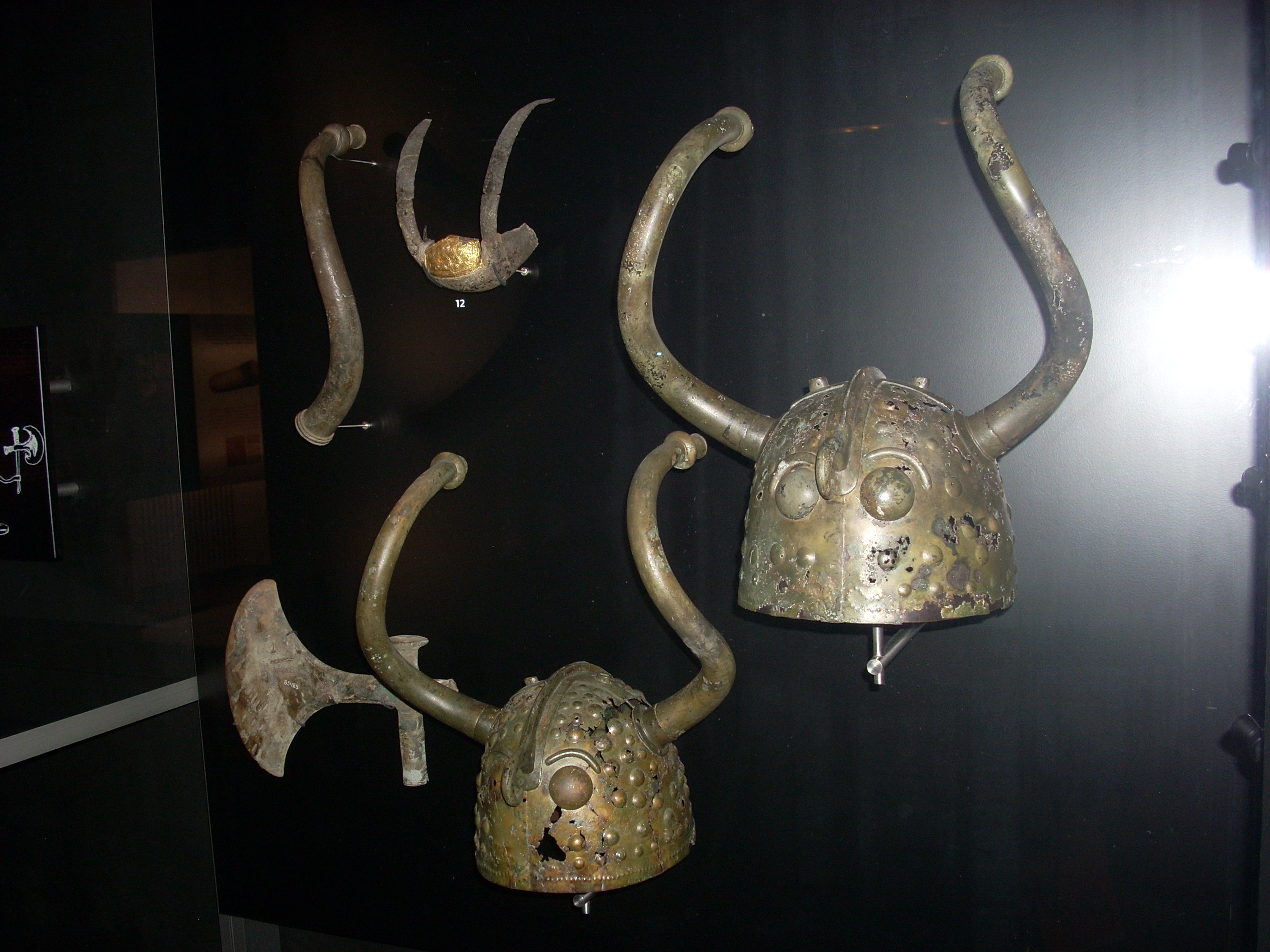 Horned Helmets
Horned HelmetsThere used to be a story that there were three types of Viking re-enactors : those with plain helmets, those with helmets with horns stuck to them and those who turned up to battle with helmets with two brown circles of old glue!
It is still a reasonably popular misconception that the Scandinavian warriors that terrorized Europe between the 8th and 12th Centuries CE had iron head-gear sprouting either horns or wings. Such is the hold of this idea on the popular imagination that it was incorporated into Stan Lee's comics, and even in the recent Thor movie gods such as Odinn, Heimdal and Loki were equipped with horned helms and Thor himself has silver wings sweeping up from the cheek-pieces of his helmet...
 |
| Waterloo Bridge Headgear (BM) |
How then did this silly idea begin? Roman authors writing from the safety of Italy began the trend. Plutarch described the Cimbri, at the time resident in Jutland, as wearing "helmets, made to resemble the heads of wild beasts," horns included. Diodorus Siculus had earlier described Gauls as wearing winged helmets or helmets with horns or antlers attached.
 |
| Gunderstrup Cauldron side showing horned headgear (NMD) |
In 1942, during peat gathering at Brøns Mose, near Veksø, two bronze helmets were found. These had long backward-curving hollow bronze horns very similar to those seen on the Gundestrup cauldron. From their construction it is instantly clear that these were not battle helms but ceremonial head-gear. They are now dated to the Early Nordic Bronze Age (1100-900 BCE).
 |
| Bronze-Age horned headgear (National Museum of Denmark) |
*(this may be an attempt to portray Wóðanaz’s ravens !)
 |
| Finglesham Buckle |
The first image of horned helmets to be found was on an engraved horn from Gallehus, Denmark, discovered in 1734 (since stolen and melted down). However, European artists had begun portraying ancient (pre-Viking) Germans wearing horned helmets as early as 1616, on the authority of the Roman writers. Since the classical authors had not specified the ceremonial purpose of the helmets, they were often seen in battle scenes. In fact, the use of horns to denote a god had been common in the Bronze Age. It is not then surprising that subsequent priests and kings wore horned headgear during religious ceremonies.
The transfer of this impractical ritual headgear from Bronze-Age priests to mainstream Nordic Warriors was largely the fault not of historians but artists. In the second half of the 18th Century, the Romantic Movement swept across Europe. Rooted in the Sturm und Drang movement, particularly in Germany, artists rejected Classical models and subjects and looked instead for inspiration to the European Medieval Period. They started to explore, among other themes, ancient Germanic and Celtic history and mythology. It must be remembered that these were artists rather than historians and they were more interested in emotions rather than strict facts. It is thus not too surprising that they sometimes showed a mixture of Germanic, Celtic and Classical motifs. The poor old Viking thus acquired Gallic-fantasy winged helmets but worse was to come.

In the early 19th Century, the Swedish artist Gustav Malmström provided the illustrations for an edition of Frithiof’s Saga by Esaias Tegnér. It proved very popular, particularly in its English translations and is largely responsible for popularizing the term ‘Viking’. Malmström’s illustrations showed, for the first time, the infamous horns on the helmets.
He had obviously got the idea from the archaeology of his time when, it must be remembered, methods of dating were considerably less exact and it had not become clear that the horned helmets found could only have ever been ceremonial. The winged helmet, however, was still illustrated, particularly in the English-speaking world, so that in August 1962 with the first appearance of Marvel’s Nordic superhero Thor (Journey into Mystery #83) Stan Lee equipped the Thunder God with a winged helmet.
In the middle of the 19th Century, Axel Holmberg, the so-called ‘Father of Nordic Petroglyphs’ credited to the Viking Age, a rock-carving showing figures with horns. He proposed that they showed iron helmets with ox-horns attached. In fact, the carvings dated to the late Bronze Age and were thus at least a thousand years too early. However, the idea became popular and it really was not until pioneers in reconstructive archaeology and historically accurate re-enactment showed the concept to be fundamentally unsound that historians began to dismiss it for the fantasy it had always been.
